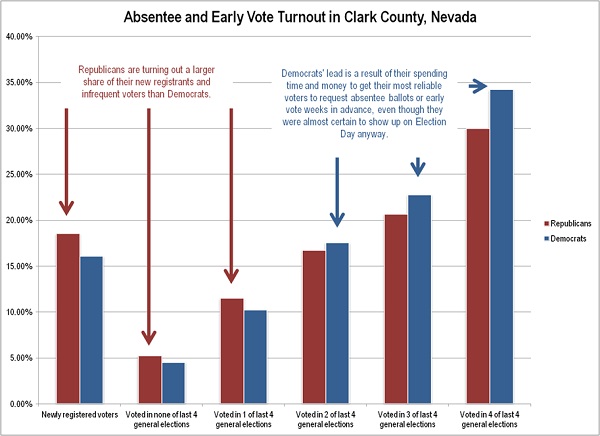October 26, 2012
MEMO
FROM: RNC Communications Director Sean Spicer @SeanSpicer
TO: Interested Parties
RE: Weekend Messaging Memo - Momentum
With eleven days left before Election Day, the choice facing voters is clear. Gov. Romney offers a bold plan for job creation and a positive vision for the future. President Obama offers the same ideas of the last four years--now available in a glossy pamphlet with big pictures.
President Obama has spent his time on the campaign trail talking about Big Bird, binders, and bayonets. On the airwaves, 70 percent of his ads have been negative. (See our graphic.)
As then-candidate Obama said in 2008, "If you don't have a record to run on, then you paint your opponent as somebody people should run from. You make a big election about small things."
Voters aren't buying it. In fact, the numbers coming in on absentee ballot requests and early voting show growing momentum for the Romney-Ryan ticket--as RNC Political Director Rick Wiley outlined in a comprehensive memo Wednesday.
Democrats have attempted to deny the signs of weakness on their side, but the facts don't lie. Republicans continue to have the strategic advantage.
Across the eight battleground states where voters register based on party affiliation, Democrats are underperforming their share of 2008 AB/EV votes cast by a net 5.56 percentage points, while Republicans are over-performing their share by 1.76 points, yielding a net swing of +7.32 percentage points for Republicans.
At the same time, Republicans are making significant gains among independents. The latest ABC News/Washington Post poll showed Gov. Romney with a 20-point lead among unaffiliated voters.
Republicans are leading absentee ballot requests and early votes in Colorado, Florida, New Hampshire, and Pennsylvania. Democrats are correct that they lead in absentee ballot requests and early votes in Iowa, Ohio, and Nevada, but we have cut into their historic advantages in those states by turning out sporadic GOP voters, while they are just trying to keep their heads above water turning out voters who would have still turned out on Election Day.
They have spent their resources getting high-propensity voters to the polls. These are voters who have cast ballots in three or four of the last four general elections and are therefore likely to vote no matter what. Getting these voters to the polls may give them the appearance of an early lead, but in the end it works to their disadvantage.
In Ohio, there are 1,005,601 registered Democrats who are high propensity voters. 42.96 percent of them have already voted or requested a ballot. There are 1,311,198 registered Republicans who have voted in at least 3 of the last 4 general elections. Only 27.27% have voted or requested a ballot. (See chart.)
That means the remaining Republican high propensity voters outnumber Democrat high propensity voters by 380,222 in Ohio.
In contrast to the Democrats, Republicans' focus has been getting low-propensity voters to cast ballots early for the Romney-Ryan ticket so that we can actually increase the total number of Republican voters in the final tally. In that effort, we have been successful thus far. That's why the Democrat early vote advantage in Ohio has dwindled every day and is significantly smaller than in 2008.
The difference in turnout between high and low propensity voters is especially obvious in Clark County, Nevada, after the first four days of early voting. As the chart below highlights, Republicans are turning out a larger share of our low propensity voters. Democrats, on the other hand, are turning out a larger share of their high propensity voters--in others words, largely wasting time and money.
In the coming days, Republicans will continue to work to get voters to the polls who otherwise would not vote. Democrats will presumably keep working to get those who will vote regardless to vote a few days earlier. That is a losing a strategy--just like binders and bayonets.

